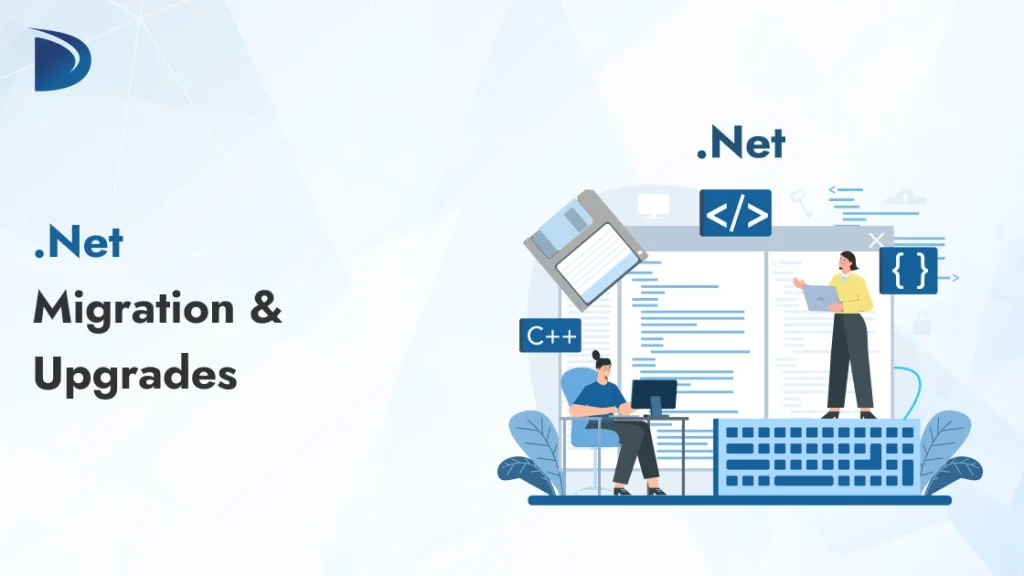Table of Contents
Our .NET migration and upgrade services help teams convert .NET Framework to .NET Core, migrate ASP.NET apps to ASP.NET Core, and manage upgrades between .NET versions. Whether you are working with outdated code or moving toward cloud-native solutions, we use Microsoft’s proven tools and a step-by-step process to minimize risks and preserve your core business logic.
If you are ready to modernize, contact us for a free consultation on .NET migration services. Make your apps future-proof.
Migrating legacy .NET Framework or ASP.NET apps to modern .NET increases speed, security, and flexibility. It also prepares your apps for cloud environments and easier maintenance. Key tools include .NET Upgrade Assistant, try-convert, and Portability Analyzer. Follow a phased plan: assess, refactor, test, and deploy. This reduces downtime and ensures a smooth transition. For businesses, this means lower costs and better user experiences.
Why Businesses Choose .NET Migration Services?
Businesses migrate to modern .NET for strong reasons. Let’s break it down.
Enhanced Security and Ongoing Support
Running outdated .NET versions such as .NET Framework 4.x exposes your applications to unpatched vulnerabilities. Microsoft’s support for older releases has ended, increasing compliance risks in industries like finance and healthcare. For example, .NET 8 is currently supported, while .NET 9 (released in 2024) and .NET 10 offer long-term support (LTS) options.
Upgrading with our .NET migration services helps you remain secure and compliant, eliminating concerns about end-of-life software.
Better Performance and Cost Savings
Modern .NET offers runtime improvements, faster JIT compilation, and optimized libraries. This reduces CPU and memory usage, resulting in quicker load times and lower hosting costs. Applications on .NET 9 or 10 can run up to 20–30% faster in benchmarks, leading to improved user satisfaction and reduced cloud expenses.
Picture reducing your Azure or AWS costs while delivering faster applications – that is the benefit of ASP.NET migration services.
Cross-Platform Flexibility and Cloud Readiness
The old .NET Framework is tied to Windows, limiting your options. Modern .NET runs on Windows, Linux, and macOS, with built-in support for containers such as Docker. This makes it easy to deploy on cloud platforms, scale horizontally, and integrate with services like Azure Functions or AWS Lambda.
For teams considering hybrid or multi-cloud setups, this flexibility is a game changer.
Increased Developer Productivity
Modern .NET offers streamlined SDKs, single-file publishing, and enhanced tooling in Visual Studio. LTS releases such as .NET 8 and .NET 10 result in fewer disruptive updates. Developers spend less time on maintenance and more on innovation, reducing technical debt.
Ready to increase your team’s efficiency? Explore our .NET upgrade services for a customized plan.
Common Goals and Approaches in .NET Modernization
Every migration has goals like better performance or cloud migration. Here are popular approaches:
Retargeting or Upgrading Versions
For apps already on modern .NET, simply update the target framework. For example, move from .NET 8 to .NET 9 or 10. This involves editing project files and updating NuGet packages.
Code Snippet Example (in .csproj file):
xml
<Project Sdk="Microsoft.NET.Sdk.Web">
<PropertyGroup>
<TargetFramework>net10.0</TargetFramework> <!-- Upgrade from net8.0 -->
</PropertyGroup>
</Project>This is quick if your code uses compatible APIs.
Porting or Refactoring
Convert .NET Framework applications to .NET Core or ASP.NET Core. This requires addressing API changes, such as replacing System.Web with Microsoft.AspNetCore.Mvc.
Approach: Refactor the code in stages, beginning with shared libraries.
Replatforming (Lift and Shift)
Host your app on newer Windows servers or Azure VMs without major changes. Use containers for quick wins, but plan full modernization later.
Rewriting as a Last Resort
For severely outdated apps, rebuild modules from scratch. This is costly but necessary if dependencies cannot be migrated.
Choose the approach based on your app’s size and business needs. Our ASP.NET migration services can help assess the best path forward.
Essential Tools for .NET Migration
Microsoft provides free tools to automate and guide migrations.
.NET Upgrade Assistant
This CLI tool analyzes and upgrades projects. Install it globally:
Code Snippet (Command Line):
bash
dotnet tool install -g upgrade-assistant
upgrade-assistant upgrade MySolution.slnIt handles project conversions and suggests fixes.
try-convert
Converts old project files to SDK-style:
bash
dotnet tool install -g try-convert
try-convert -w MyProject.csprojGreat for initial automation.
.NET Portability Analyzer
Scans for non-portable APIs:
Download from NuGet or use in Visual Studio.
Additional Tools: Analyzers and CI
Integrate Roslyn analyzers in CI pipelines (e.g., GitHub Actions) for early issue detection.
These tools make .NET framework migration efficient.
Recommended Step-by-Step Migration Process
Follow this checklist for success:
1. Assess and Inventory
List all projects, dependencies, and features. Run:
bash
upgrade-assistant analyze MySolution.slnGet a report on compatibility.
2. Classify Modules
Group as straightforward, refactor, or rewrite.
3. Proof-of-Concept
Migrate a small module end-to-end. Fix issues like:
Code Snippet (Updating Startup.cs for ASP.NET Core):
csharp
public class Startup
{
public void ConfigureServices(IServiceCollection services)
{
services.AddControllers(); // Replace old MVC setup
}
}4. Phased Porting
Use the strangler pattern: Modernize one service at a time.
5. Upgrade Dependencies
Update NuGet packages:
bash
dotnet add package Microsoft.AspNetCore.Mvc --version 10.0.0Find alternatives if needed.
6. Testing and Validation
Add unit tests with xUnit:
Code Snippet:
csharp
[Fact]
public void TestMethod()
{
Assert.True(1 + 1 == 2);
}Run benchmarks.
7. Security and Configuration
Update to modern auth like IdentityServer or Azure AD.
8. Deploy and Monitor
Use blue-green deployments. Monitor with Application Insights.
This process ensures minimal disruption.
Typical Challenges and Solutions
Handling System.Web and WebForms
These are Windows-only. Solution: Extract logic to .NET Standard libraries, then rewrite UI.
Native/COM Interop
Use Windows containers or recompile.
Unsupported Packages
Replace or adapt.
Build Complexities
Manual MSBuild tweaks after try-convert.
Our .NET migration services handle these expertly.
ROI and Risks: What to Expect
Migration pays off with 20-50% cost savings on hosting and faster dev cycles. Risks include temporary downtime, but phased approaches minimize this.
Prioritize high-impact modules for quick wins.
Conclusion
Modern .NET migration is essential for competitive applications. With improved performance, security, and scalability, it is an investment in your future.
Ready to begin? Contact us today for .NET migration services or a custom quote for ASP.NET migration services.
FAQs
What are .NET migration services?
.NET migration services help businesses move legacy .NET Framework or ASP.NET applications to modern .NET versions (such as .NET 8, 9, or 10) or upgrade between .NET versions. These services enhance performance, security, cloud compatibility, and maintainability using tools like .NET Upgrade Assistant and try-convert.
Why should I migrate my .NET Framework app to modern .NET?
Migrating offers:
- Security: Avoid unpatched vulnerabilities in unsupported .NET Framework versions.
- Performance: Modern .NET reduces CPU/memory usage, cutting hosting costs.
- Cross-platform: Run apps on Windows, Linux, or macOS with container support.
- Developer efficiency: Streamlined SDKs and LTS releases speed up development.
What’s the difference between .NET Framework and modern .NET?
.NET Framework is Windows-only and older, with limited updates. Modern .NET (such as .NET Core, .NET 8, 9, and 10) is cross-platform, cloud-friendly, and optimized for performance. It supports containers and offers long-term support (LTS) releases.
What is ASP.NET migration?
ASP.NET migration involves converting legacy ASP.NET applications built on the .NET Framework with System.Web to ASP.NET Core, which runs on modern .NET. This process requires updating APIs, refactoring code, and replacing dependencies to improve scalability and cross-platform support.
How long does a .NET migration take?
The timeline depends on app complexity, size, and migration approach (retarget, port, replatform, or rewrite). Small projects may take weeks, while large monoliths can take months. A phased approach reduces disruption.
What tools are used for .NET migration?
Key tools include:
- .NET Upgrade Assistant: Analyzes and automates project upgrades.
- try-convert: Converts old project files to SDK-style format.
- .NET Portability Analyzer: Identifies non-portable APIs.
- CI pipelines and analyzers: Catch issues early with automated tests.
Example command for .NET Upgrade Assistant:
dotnet tool install -g upgrade-assistant
upgrade-assistant upgrade MySolution.slnWhat are the main approaches to .NET migration?
- Retarget/Upgrade: Update to a newer .NET version (e.g., .NET 8 to 10).
- Port/Refactor: Convert .NET Framework to .NET Core/ASP.NET Core.
- Replatform: Move to newer servers or cloud VMs without major changes.
- Rewrite: Rebuild outdated modules (used as a last resort).
What is the recommended migration process?
Follow these steps:
- Assess: Inventory projects and dependencies; run Portability Analyzer.
- Classify: Mark modules as straightforward, refactor, or rewrite.
- Proof-of-Concept: Migrate a small module to test the process.
- Phased Porting: Modernize modules gradually using the strangler pattern.
- Upgrade Dependencies: Update or replace NuGet packages.
- Test: Use unit, integration, and smoke tests in CI pipelines.
- Secure: Update authentication and configuration (e.g., Kestrel for ASP.NET Core).
- Deploy: Use staging, canary, or blue-green deployments and monitor performance.
What challenges might I face during .NET migration?
Common issues include:
- System.Web/WebForms: Windows-specific; requires refactoring or rewriting.
- Native/COM Interop: May need Windows containers or recompilation.
- Unsupported NuGet Packages: Replace or find alternatives.
- Complex Builds: Manual MSBuild adjustments for custom tasks.
Solutions involve isolating logic, using containers, or finding vendor support.
How do I handle System.Web or WebForms in migration?
System.Web and WebForms do not work in modern .NET. Extract business logic to .NET Standard libraries, then rewrite the UI in ASP.NET Core or add a façade layer.
Example (Extracting logic to a library):
// In a .NET Standard library
public class BusinessLogic
{
public string ProcessData(string input) => input.ToUpper();
}What are the benefits of migrating to modern .NET?
- Cost Savings: Lower hosting costs due to reduced CPU/memory usage.
- Performance: Up to 20-30% faster apps in benchmarks.
- Business Continuity: Phased migrations minimize user disruption.
- Developer Productivity: Modern tools reduce maintenance and onboarding time.
Can I migrate my app to the cloud during .NET modernization?
Yes. Modern .NET is cloud-friendly, supporting Azure, AWS, and container platforms such as Kubernetes. Replatform to Azure App Service or containerize for AKS or EKS.
How do I ensure my app works after migration?
- Build a test suite (unit, integration, contract, smoke tests).
- Automate tests in CI pipelines (e.g., GitHub Actions).
- Run performance benchmarks and monitor telemetry post-deployment.
Example xUnit test:
[Fact]
public void TestBusinessLogic()
{
var logic = new BusinessLogic();
Assert.Equal("TEST", logic.ProcessData("test"));
}What is the strangler pattern in .NET migration?
The strangler pattern modernizes one module at a time while keeping the application running. Traffic is gradually routed to the updated module, reducing risk in large monoliths.
How do I start a .NET migration project?
Contact our .NET migration services for a free assessment. We will analyze your app, recommend tools, and create a phased plan. Visit our website for a consultation or download our migration checklist.
Can I upgrade from .NET 6 to .NET 10 directly?
Yes, but it’s better to upgrade incrementally (e.g., .NET 6 → 8 → 10) to manage API changes. Use the .NET Upgrade Assistant to automate updates.
Example .csproj update:
<TargetFramework>net10.0</TargetFramework>What are the costs of .NET migration?
Costs depend on app size, complexity, and approach. You can expect savings from lower hosting fees and reduced maintenance. Our ASP.NET migration services provide tailored quotes.
Where can I learn more about .NET migration?
- Microsoft .NET Upgrade Docs
- .NET Upgrade Assistant
- try-convert GitHub
- .NET Blog for Performance
How do I get started with your .NET migration services?
Contact us for a free consultation. Our team specializes in .NET Framework migration and ASP.NET migration services. Schedule a demo or download our migration checklist on our website.

